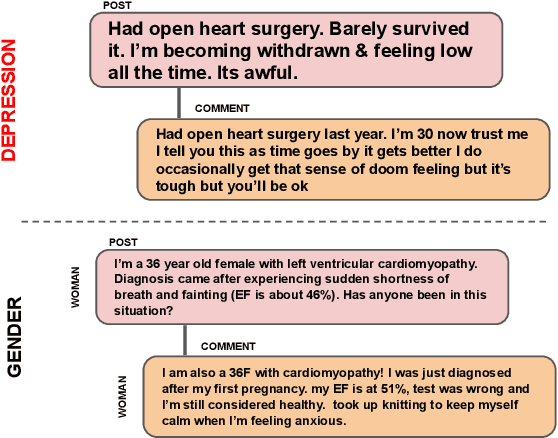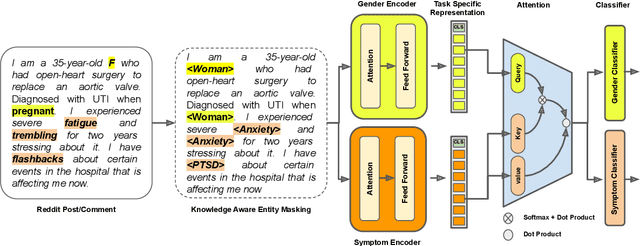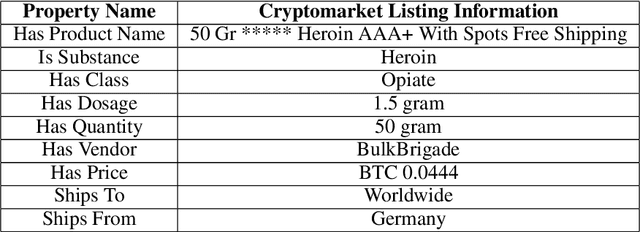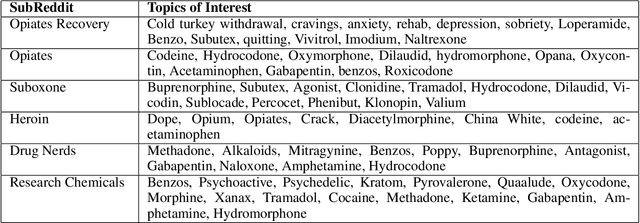Triyasha Ghosh Dastidar
"Can We Detect Substance Use Disorder?": Knowledge and Time Aware Classification on Social Media from Darkweb
Apr 20, 2023Abstract:Opioid and substance misuse is rampant in the United States today, with the phenomenon known as the "opioid crisis". The relationship between substance use and mental health has been extensively studied, with one possible relationship being: substance misuse causes poor mental health. However, the lack of evidence on the relationship has resulted in opioids being largely inaccessible through legal means. This study analyzes the substance use posts on social media with opioids being sold through crypto market listings. We use the Drug Abuse Ontology, state-of-the-art deep learning, and knowledge-aware BERT-based models to generate sentiment and emotion for the social media posts to understand users' perceptions on social media by investigating questions such as: which synthetic opioids people are optimistic, neutral, or negative about? or what kind of drugs induced fear and sorrow? or what kind of drugs people love or are thankful about? or which drugs people think negatively about? or which opioids cause little to no sentimental reaction. We discuss how we crawled crypto market data and its use in extracting posts for fentanyl, fentanyl analogs, and other novel synthetic opioids. We also perform topic analysis associated with the generated sentiments and emotions to understand which topics correlate with people's responses to various drugs. Additionally, we analyze time-aware neural models built on these features while considering historical sentiment and emotional activity of posts related to a drug. The most effective model performs well (statistically significant) with (macroF1=82.12, recall =83.58) to identify substance use disorder.
A Computational Approach to Understand Mental Health from Reddit: Knowledge-aware Multitask Learning Framework
Mar 22, 2022



Abstract:Analyzing gender is critical to study mental health (MH) support in CVD (cardiovascular disease). The existing studies on using social media for extracting MH symptoms consider symptom detection and tend to ignore user context, disease, or gender. The current study aims to design and evaluate a system to capture how MH symptoms associated with CVD are expressed differently with the gender on social media. We observe that the reliable detection of MH symptoms expressed by persons with heart disease in user posts is challenging because of the co-existence of (dis)similar MH symptoms in one post and due to variation in the description of symptoms based on gender. We collect a corpus of $150k$ items (posts and comments) annotated using the subreddit labels and transfer learning approaches. We propose GeM, a novel task-adaptive multi-task learning approach to identify the MH symptoms in CVD patients based on gender. Specifically, we adapt a knowledge-assisted RoBERTa based bi-encoder model to capture CVD-related MH symptoms. Moreover, it enhances the reliability for differentiating the gender language in MH symptoms when compared to the state-of-art language models. Our model achieves high (statistically significant) performance and predicts four labels of MH issues and two gender labels, which outperforms RoBERTa, improving the recall by 2.14% on the symptom identification task and by 2.55% on the gender identification task.
eDarkTrends: Harnessing Social Media Trends in Substance use disorders for Opioid Listings on Cryptomarket
Mar 29, 2021



Abstract:Opioid and substance misuse is rampant in the United States today, with the phenomenon known as the opioid crisis. The relationship between substance use and mental health has been extensively studied, with one possible relationship being substance misuse causes poor mental health. However, the lack of evidence on the relationship has resulted in opioids being largely inaccessible through legal means. This study analyzes the substance misuse posts on social media with the opioids being sold through crypto market listings. We use the Drug Abuse Ontology, state-of-the-art deep learning, and BERT-based models to generate sentiment and emotion for the social media posts to understand user perception on social media by investigating questions such as, which synthetic opioids people are optimistic, neutral, or negative about or what kind of drugs induced fear and sorrow or what kind of drugs people love or thankful about or which drug people think negatively about or which opioids cause little to no sentimental reaction. We also perform topic analysis associated with the generated sentiments and emotions to understand which topics correlate with people's responses to various drugs. Our findings can help shape policy to help isolate opioid use cases where timely intervention may be required to prevent adverse consequences, prevent overdose-related deaths, and worsen the epidemic.
 Add to Chrome
Add to Chrome Add to Firefox
Add to Firefox Add to Edge
Add to Edge